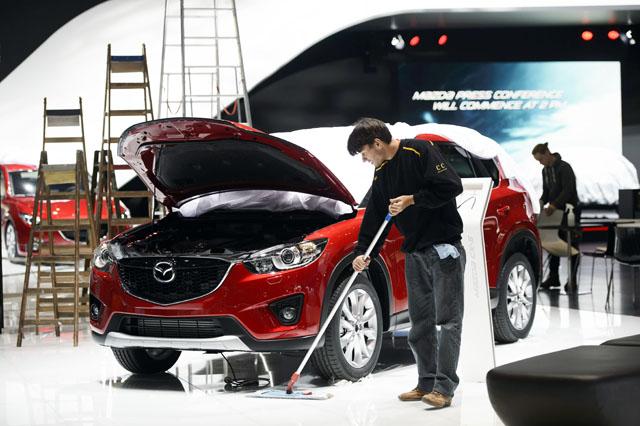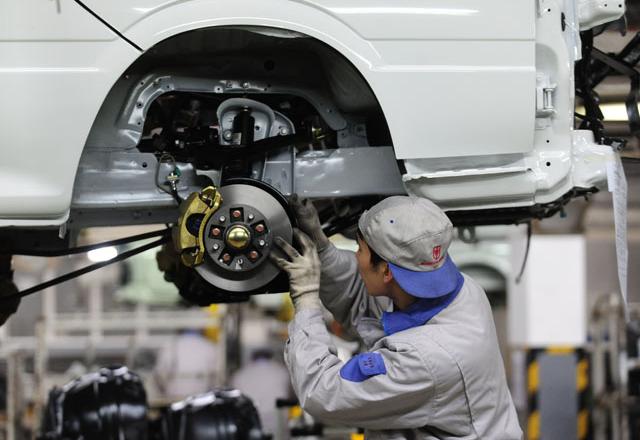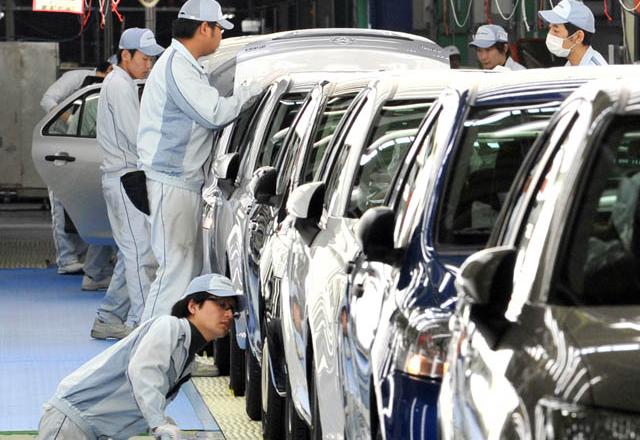You are here
Geneva motor show set to make tracks out of crisis
By AFP - Mar 02,2014 - Last updated at Mar 02,2014

PARIS — The Geneva Motor Show will kick off this week on an optimistic note as the long-suffering European car market appears to finally have swerved out of the slow lane.
Luxurious sports cars, high-end SUVs and city cars will be bumper-to-bumper at the show — one of the auto industry’s biggest and most diverse events — as it cruises out from under the long shadow of industry crisis.
Carmakers and analysts alike say the worst of the difficulties are now in the rear-view mirror.
“The worst of the crisis is over, so the mood should be good,” said Juergen Pieper, a car industry analyst with German bank Metzler.
New car registrations in the European Union slipped just 1.7 per cent last year, to 11.8 million cars sold, after five years of far more brutal falls.
But sales are finally expected to pick up this year, according to German car industry analyst Stefan Bratzel.
By how much remains to be seen: the most cautious observers expect sales to remain flat while the most optimistic are gearing up for 3 per cent market growth.
“The markets fell really low, so obviously they will have to start picking up at some point,” EY analyst Jean-Francois Belorgey said, adding that northern Europe was doing better than the south of the continent.
France remained a dark spot on the European map, seeing car sales in 2013 fall to their lowest level in 15 years with little prospect of growth this year, while Italy also touched rock-bottom, selling just 1.3 million cars.
“The economic fundamentals in France and Italy remain fragile,” Belorgey acknowledged.
And despite the expected upturn this year, Europe’s car industry remains plagued by overcapacity and profitability issues for mid-range carmakers, according to credit insurance and analysis group Euler Hermes, pointing to several recent factory closings, at PSA, Opel and Ford.
Range of new models
German carmakers, who sell heavily in North America and Asia where sales — especially at the high end — are up, are meanwhile doing quite well.
Their international presence allows them to counter still sluggish sales in Europe and keep their factories running at full-tilt.
Volkswagen raked in a net profit of 9.1 billion euros ($12.6 billion) last year, while Daimler, which owns Mercedes-Benz and Smart among others, posted a record net profit of 8.7 billion euros.
And the German manufacturers are aiming for even better traction with a range of new products, including the Volkswagen’s third generation Audi TT and a new BMW compact.
France’s Renault and Italy’s Fiat have seen far more modest profits, while PSA Peugeot Citroen suffered a 2.3 billion-euro loss last year, although it hopes a cash injection from the French state and China’s Dongfeng will put it on the road to recovery.
Despite their continued hardship, French carmakers should play a more central role at this year’s Geneva Motor Show, where smaller city cars are expected to get more attention than previously.
“They are presenting a number of important new products,” Pieper said, listing for instance Renault’s launch of a new Twingo, which will face off against the Citroen C1 and Peugeot 108.
Such small, punchy city vehicles will as always have to battle for attention with exceptional, luxury cars at the 84th edition of the Geneva car show.
While the show will not feature last year’s overwhelming display of extravagant machines priced over the million dollar mark, there will still be plenty to see for car enthusiasts.
Ferrari’s new version of its California T sport car and Lamborghini’s new Huracan, both priced at round 200,000 euros, will likely draw crowds.
But perhaps the most popular attraction at this year’s show, set to open to the public from March 6-16, will be something in between: super trendy SUVs and crossovers.
Porsche, once known only as a sport car maker, will for instance speed into the mid-size SUV range with its new Macan, in the hope it will prove as popular as its big sister Cayenne, which accounts for more than half of the carmakers sales.
American carmaker Ford is meanwhile revving up to unveil a third installment of its hugely popular compact Focus — the world’s most sold model.
Separately, the China Association of Automobile Manufacturers (CAAM) said that China’s auto sales smashed through the 20 million mark last year, growing nearly 14 per cent and extending its lead as the world’s biggest car market.
Sales in China, the world’s biggest auto market since 2009, surged 13.9 per cent to 21.98 million vehicles last year, the CAAM indicated, as a recovery in Japanese brands offset the impact of slowing economic growth.
Passenger vehicle sales jumped 15.7 per cent year-on-year to 17.93 million units, the group pointed out in a statement.
China’s huge auto market is critically important to foreign companies, which have looked to its vast potential to take up the slack from flagging sales in Europe, where French car sales hit a 15-year low in 2013 and German car sales also fell.
In the United States, total auto sales rose 7.6 per cent to 15.6 million vehicles in 2013, according to Autodata, their best annual performance in years.
In 2012, Chinese auto sales had risen just 4.3 per cent annually to 19.31 million vehicles, hurt by slowing domestic economic growth, limits on car numbers imposed by some cities to cut pollution and congestion, and a territorial row between Beijing and Tokyo that hit sales of Japanese-brand cars.
But Japanese brands have continued to recover from the downturn in 2012, when political tensions grew over disputed islands in the East China Sea, causing some consumers to shun their Asian neighbour’s products.
“Although the economic situation was bad in 2013, there were many catalysts for the car industry,” said Cui Dongshu, deputy secretary general of the China Passenger Car Association, another industry group.
“There was strong demand for replacing old vehicles with new ones. Japanese brands also rebounded after their downturn in 2012 as domestic consumers have high regard for them,” he told AFP.
In its figures, CAAM said sales of Japanese-brand passenger cars amounted to 2.93 million in 2013, but gave no percentage change.
In December alone, total vehicle sales in China — both passenger and commercial — rose 17.9 per cent year-on-year to 2.13 million units, CAAM added.
Some foreign companies have already announced record China sales in 2013.
US auto giant General Motors (GM) sold 3.16 million vehicles in the country last year, up 11.4 per cent from 2012.
“GM maintained good growth momentum in our company’s largest market, despite a modest slowdown in demand for commercial vehicles,” president of GM China, Matt Tsien, said in a statement.
Competitor Ford sold 935,813 vehicles in China last year, up 49 per cent from 2012, as the US company introduced more new vehicles to the market.
But analysts said auto sales could slow this year from 2013.
“Surging sales are expected to see a slowdown as government restrictions curbing new vehicle sales are enforced across cities in China, as the levels of pollution hit record highs,” IHS Automotive senior analyst Namrita Chow said in a recent report.
In January, the northern city of Tianjin became the latest to limit cars by capping the number of licence plates it issues annually.
IHS forecasts passenger vehicle sales will rise around 10.4 per cent this year.
Cui of the China Passenger Car Association forecasts vehicle sales will rise ten to 12 per cent this year, as the one-off boost from the improvement for Japanese brands eases.
Related Articles
China's trade surplus soared by almost half last year to a record $382 billion, the government announced Tuesday, but the world's second-largest economy again missed its trade growth target due to weakness overseas.
Toyota sold a record 9.98 million vehicles last year, it pointed out Thursday, outpacing rivals General Motors (GM) and Volkswagen to maintain its title of world’s biggest automaker.
FRANKFURT AM MAIN — Carmakers built just 4.7 million cars in Germany in 2019, industry data showed on Monday, squeezing production to its lo













